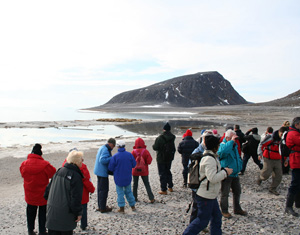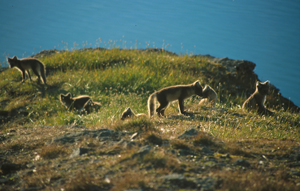Traffic and wildlife in SvalbardBy Øystein OverreinThe Svalbard Environmental Protection Act includes the principle of duty of care:”Any person who is staying in or operates an undertaking in Svalbard shall show due consideration and exercise the caution required to avoid unnecessary damage or disturbance to the natural environment or cultural heritage.” Further: “It is prohibited to chase, catch or kill fauna or damage eggs, nests or dens without authorization.” The provision of duty of care is perhaps the most violated of the environmental provisions. Photographing, video recording, people’s desire to meet with Svalbard’s wildlife and negligent traffic in these areas can easily lead to unnecessary disturbance of birds and mammals. Disturbances may cause the individuals affected to fail to reproduce in a particular season – for instance common eiders, Arctic terns or geese on the nests. The most extreme incidents of disturbance include the pursuit of polar bears by snowmobiles, seeking out polar bears in summer, landings at islets and skerries during the breeding season of eiders and geese and close contact with walruses at sea when passing with kayaks or small boats. Such behaviour may put both people and wildlife in danger. Increased loss of eggs and chicks is guaranteed if a breeding colony is disturbed. All of this highlights the importance of always exercising care when travelling in Svalbard. In this section we give some advice on how to perform in the natural environment of Svalbard, as to minimize the effect of human presence on wildlife, focusing on the most relevant species. Main principleThe rule of thumb is to avoid altering the behaviour of the animals as a result of our presence in their habitat. Polar bearThe Svalbard Environmental Protection Act includes strict provisions on how to act upon encounters of polar bears (see sub-chapter Traffic Regulations). To see the “King of the Arctic” in its element is for many visitors to Svalbard the ultimate wilderness experience. Unfortunately, people often go too far to get such experiences. Remember that the provisions given in the act apply to encounters of polar bears in drift ice, on ice floes or in the water, as well as on land. When a polar bear alters its behaviour because of people’s presence, we have violated the limits. The result may be that the polar bear must be scared off with a flare gun or, at the worst, a self-defence situation may occcur in which the only way out is shooting the bear. The polar bear is fearless and usually curious, but also unpredictable. The most problematic bears are generally young bears or hungry individuals during summer. The following precautions need to be considered upon travelling in areas where polar bears may be encountered:
If all attempts to scare off the bear fails, and retreat is impossible, killing the bear in self-defense can be the only solution. Place the shot, using a big-game rifle (alternatively a shotgun with slugs), in the shoulder or chest area. Heavy-caliber revolvers may be used, but only by skilled gunmen. Never shoot at the head, as the bullet may bounce off the skull. Shoot until the bear is immobile. Killing of a polar bear must be reported immediately to the Governor of Svalbard, regardless of the circumstances. The bear carcass and the area around it must be kept intact for later investigations. 
WalrusNext to the polar bear, the walrus is one of Svalbard’s greatest tourist attractions. Nowhere else walruses are more accessible and less shy of people than here. Be aware that despite its sedate and listless appearance on land, this animal can move rapidly in the water and can be dangerous when lunging its tusks. The most important advice for visitors follows:
Ringed sealAlthough there are about 100 000 ringed seals in Svalbard, they can be hard to spot in summertime. When observed it is usually swimming in the ocean or resting on ice floes. The ringed seal is normally seen in the waters at glacier fronts, in the northern parts of the archipelago or by the sea ice edge. They are usually shy and quickly enter the water and dive when people get too close. Summer traffic in Svalbard is unproblematic to the ringed seal. Bearded sealThe female bearded seal gives birth to a single pup on an ice floe in May. At this time of the year it is important to keep a distance when travelling by boat to avoid disturbing the mother and pup. Later in summer it is possible to get very close to individuals resting on ice floes, if approaching very slowly and with very little noise. If the animal starts to move its head or limbs or looks as if it will enter the water, it is time to stop and not get any closer. Harbour sealThere is a small population of harbour seals on the west coast of Spitsbergen. They give birth to their pups in June on rocky shores or on skerries. Do not disturb the seals during this period. If panicked, the mother and pup may be separated. Several harbour seal birthing areas are located in bird sanctuaries. The general prohibition against traffic within 300 m off land in bird sanctuaries shields both seals and birds from disturbances. If you come across harbour seals with small pups in other areas, keep a distance of at least 100 m. Sometimes adult seals will visit boats. Turn off the engine so the seal will not get hurt by the propeller. Seals may even try to play with the propeller – a dangerous game. WhalesWhales are easily spotted from far away by their blow. For closer contact, drive the boat at low speed parallel to the course in which the whale is swimming. Never cross the path of a swimming whale, and never encircle or chase a whale! Some species, like minke whale, humpback whale and white-beaked dolphin, are curious by nature and will often seek out boats lying still or travelling at low speed. Other species, like white whale (beluga) and narwhal, are easily scared off by engine noise. To be able to observe the latter two, switching off the engine or leaving it in neutral position is the best tip. 
Arctic foxThe Arctic fox is often perceived as extremely confident and fearless. However, during the breeding season (May-August) it is generally shy. The following advice applies to travelling in areas with Arctic fox:
Svalbard reindeerThe Svalbard reindeer is normally shy towards people. The reaction to human presence varies with the area and how we move around (by foot, skis, snow mobiles, speed, direction etc.). Season, weather, condition and the condition of the animal, its age and sex also influence the situation. Females with newborn calves may be extremely shy. In areas of regular human traffic, the reindeers are often used to human presence.
Eiders, other ducks and geeseEiders and other duck species often breed concentrated on small islands, islets or headlands. Geese also breed beneath bird cliffs, in moraines or along brinks facing the ocean, river ravines or gorges. Traffic in such areas will scare brooding birds off the nest. As a consequence of the exposure, there is a higher chance of Arctic foxes, glaucous gulls or Arctic skuas preying on the eggs.
WadersBrooding waders are usually not spotted until one flies off the nest just in front of your feet. Purple sandpiper and other waders will act as if injured, dragging their wings along the ground, if the nest area is intruded upon. This broken-wing display is intended to draw the intruder’s attention away from the nest or the chicks. If you have scared a bird off its nest, make a retreat – alternatively follow the play-acting adult bird out of the area. Arctic skua, great skua and Arctic ternThe two species of skua nest in solitary pairs. The Arctic tern breeds in colonies. All three species are intensively alert to potential intruders, including human visitors. They first scream loudly then fearlessly attack. Keep your arm or a stick above your head and calmly make a retreat. Do not aim at the bird! Bird cliff species/seabirdsBlack-legged kittiwake, northern fulmar, Atlantic puffin, Brünnich’s guillemot, common guillemot, ivory gull and other species nest concentrated in bird cliffs of various sizes. Little auks also nest in large colonies, but these are located in steep screes. Visits to bird cliffs normally influence only the lowest and most accessible parts of the colonies. Disturbance leading to the adult bird leaving the nest/nest site/egg(s) may, at worst, result in the loss of eggs or chicks. Glaucous gulls patrol the bird cliffs and quickly steals unprotected eggs or chicks.
Further guidelines for visitors to the Arctic can be found at the AECO (Association of Arctic Expedition Cruise Operators) web site. Updated April 2009 |
The Cruise Handbook is also available in book formHard cover with numerous pictures - 249 pages - NOK 249.00 Norwegian Polar Institute |
 Norsk
Norsk